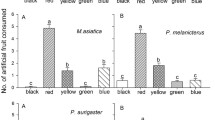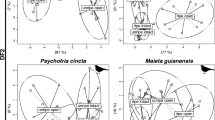Abstract
Although many studies have been published on avian fruit selection, few have addressed the effects of fruit scarcity on the patterns of fruit choice. Here, we compared the consumption of seven bird species for six simultaneously present maturation stages of Goupia glabra fruits. Ripe G. glabra fruits contain more lipids, carbohydrates and energy, and fewer phenols, than unripe fruits. All bird species selected from among ripening stages and removed a higher proportion of ripe fruits than of intermediate or unripe fruits. Importantly, however, fruit choice was flexible in all species. Whether birds preferred or avoided fruits of intermediate ripeness depended on the overall fruit supply. When ripe fruits were scarce, birds showed a higher acceptance of fruits of intermediate ripeness, but still rejected the least ripe fruit stages. In a foraging bout, most birds fed on fruits of the same ripeness. By doing so, birds maximised instantaneous energy gain per time, because search time was longer for riper fruits while energy intake was lower for less ripe fruits. The results suggest that birds select fruits based on fine-scale differences in profitability, but accept less profitable fruits during low fruit abundance. If environmental factors such as overall fruit availability influence avian fruit choice, we suggest that the potential for directional selective pressures on fruit compounds is restricted.


Similar content being viewed by others
References
Anhuf D, Winkler H (1999) Geographical settings of the Surumoni-Crane-Project (Upper Orinoco, Estado Amazonas, Venezuela). Österreichische Akademie, Anzeiger Abteilung I 135:3–23
Appel HM (1993) Phenolics in ecological interactions: the importance of oxidation. J Chem Ecol 19:1521–1552
Bergman CM, Fryxell JM, Cormack Gates C, Fortin D (2001) Ungulate foraging strategies: energy maximizing or time minimizing? J Anim Ecol 70:289–300
Borowicz VA (1988) Fruit consumption by birds in relation to fat content of pulp. Am Midl Nat 119:121–127
Chesson J (1978) Measuring preferences in selective predation. Ecology 59:211–215
Cipollini ML, Levey DJ (1997) Why are some fruits toxic? Glycoalkaloids in Solanum and fruit choice by vertebrates. Ecology 78:782–798
Clark L, Shah PS, Mason JR (1991) Chemical repellency in birds; relationship between chemical structure and avoidance response. J Exp Zool 260:310–322
Foley WJ, McArthur C (1994) The effects and costs of ingested allelochemicals in mammals: an ecological perspective. In: Chivers DJ, Langer P (eds) The digestive system in mammals: food, form and function. Cambridge University Press, Cambridge, pp 370–391
Foster RB (1982) Famine on Barro Colorado Island. In: Leigh EG Jr., Rand AS, Windsor DM (eds) The ecology of a tropical forest. Seasonal rhythms and long-term changes. Smithsonian Institution Press, Washington, pp 201–212
Foster MS (1977) Ecological and nutritional effects of food scarcity on a tropical frugivorous bird and it’s fruit source. Ecology 58:73–85
Fuentes M (1994) Diets of fruit-eating birds: what are the causes of interspecific differences? Oecologia 97:134–142
García D, Zamora R, Gómez JM, Hodar JA (1999) Bird rejection of unhealthy fruits reinforces the mutualism between juniper and its avian dispersers. Oikos 85:536–544
Gervais JA, Noon BR, Willson MF (1999) Avian selection of the color-dimorphic fruits of salmonberry, Rubus spectabilis: a field experiment. Oikos 84:77–86
Guglielmo CG, Jakubas WJ, Karasov W. H. (1996) Nutritional costs of a plant secondary metabolite explain the selective foraging by ruffed grouse. Ecology 77:1103–1115
Herrera CM (1998) Long-term dynamics of mediterranean frugivorous birds and fleshy fruits: a 12-year study. Ecol Monogr 68:511–538
Johnson RA, Willson MF, Thompson JN (1985) Nutritional values of wild fruit and consumption by migrant frugivorous birds. Ecology 66:819–827
Leck CF (1972) Seasonal changes in feeding pressures of fruit- and nectar-eating birds in Panamá. Condor 74:54–60
Lepzyk CA, Murray KG, Winnett-Murray K, Bartell P, Geyer E Work T (2000) Seasonal fruit preference for lipids and sugars by American robins. Auk 117:709–717
Levey DJ (1987) Sugar-tasting ability and fruit selection in tropical fruit-eating birds. Auk 104:173–179
Mantovarani A (1998) Fenologia e aspectos da biologia reproductiva de Euterpe edulis em floresta atlantica no Sul do Brasil. MSc Thesis, Universidade Estadual Paulista
Moegenburg SM, Levey DJ (2003) Do frugivores respond to fruit harvest? An experimental study of short-term responses. Ecology 84:2600–2612
Provenza FD, Burritt EA, Clausen TP, Byrant JP, Reichardt PB, Distel RA (1990) Conditioned flavor aversion: a mechanism for goats to avoid condensed tannins in blackbrush. Am Nat 136:801–826
Sallabanks R (1993) Hierarchical mechanisms of fruit selection by an avian frugivore. Ecology 74:1326–1336
Schaefer HM, Schmidt V, Wesenberg J (2002) Vertical stratification and caloric content of fleshy fruit production and standing crop in a tropical lowland forest. Biotropica 34:244–253
Schaefer HM, Schmidt V, Winkler H (2003a) Testing the defence trade-off hypothesis: how contents of nutrients and secondary compounds affect fruit removal. Oikos 102:318–328
Schaefer HM, Schmidt V, Bairlein F (2003b) Discrimination abilities for the main nutrients - which difference matters for choosy birds and why? Anim Behav 65:531–541
Schmidt V, Schaefer HM, Winkler H (2004) Conspicuousness, not colour as foraging cue in plant-animal interactions. Oikos 106:551–557
Thanos CA (1994) Aristotle and Theophrastus on plant-animal interactions. In: Arianoutsou M, Groves RH (eds) Plant–animal interactions in mediterranean-type ecosystems. Kluwer, Dordrecht, pp 3–11
Thébaud C, Debussche M (1992) A field test of the effects of infructescence size on fruit removal by birds in Viburnum tinus. Oikos 65:391–394
Whelan CJ, Willson MF (1994) Fruit choice in migrating North American birds: field and aviary experiments. Oikos 71:137–151
Willson MF (1994) Fruit choices by captive American robins. Condor 96:494–502
Witmer MC, Van Soest PJ (1998) Contrasting digestive strategies of fruit-eating birds. Funct Ecol 12:728–741
Acknowledgements
We thank F. Harder for his help in the field work, Franz Bairlein, Hans Winkler, Doug Levey and an anonymous reviewer for their many valuable comments on the manuscript. The study was conducted under permit no. 193 of the SADA Amazonas office, Venezuela.
Author information
Authors and Affiliations
Corresponding author
Additional information
Communicated by F. Bairlein
Rights and permissions
About this article
Cite this article
Schaefer, H.M., Schaefer, V. The fruits of selectivity: how birds forage on Goupia glabra fruits of different ripeness. J Ornithol 147, 638–643 (2006). https://doi.org/10.1007/s10336-006-0089-x
Received:
Revised:
Accepted:
Published:
Issue Date:
DOI: https://doi.org/10.1007/s10336-006-0089-x




